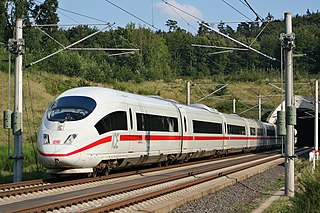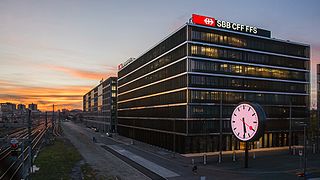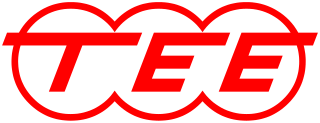
Intercity Express is a high-speed rail system in Germany. It also serves destinations in Austria, France, Belgium, Switzerland and the Netherlands as part of cross-border services. It is the flagship of the German state railway, Deutsche Bahn. ICE fares are fixed for station-to-station connections, on the grounds that the trains have a higher level of comfort. Travelling at speeds up to 300 km/h (190 mph) within Germany and 320 km/h (200 mph) when in France, they are aimed at business travellers and long-distance commuters and marketed by Deutsche Bahn as an alternative to flights.

Swiss Federal Railways is the national railway company of Switzerland.

CityRail was a passenger railway brand operated by the State Rail Authority from 1989 to 2003 and by RailCorp from 2003 to 2013 with services in and around Sydney, Newcastle and Wollongong, the three largest cities in New South Wales, Australia. It was established in January 1989 and abolished in June 2013 when it was superseded by Sydney Trains and NSW TrainLink.

InterCity is the classification applied to certain long-distance passenger train services in Europe. Such trains generally call at major stations only.

The Trans Europ Express, or Trans-Europe Express (TEE), was an international first-class railway service in western and central Europe that was founded in 1957 and ceased in 1995. At the height of its operations, in 1974, the TEE network comprised 45 trains, connecting 130 different cities, from Spain in the west to Austria in the east, and from Denmark to Southern Italy.

The ICE 2 is the second series of German high-speed trains and one of six in the Intercity-Express family since 1995. The ICE 2 (half-) trains are even closer to a conventional push–pull train than the ICE 1, because each train consists of only one locomotive, six passenger cars and a cab car. The maximum speed is 280 km/h (175 mph), but this is limited to 250 km/h (155 mph) when the cab car is leading the train and even further down to 160 km/h (100 mph) when two units are coupled at the powerheads due to the forces on the overhead line by their respective pantographs.

Würzburg Hauptbahnhof is a railway station for the city of Würzburg in the German state of Bavaria. It was opened in 1864 to the north of the inner city as a replacement for the former Ludwigsbahnhof in the city centre, the capacity of which had been exhausted by the dramatic increase of rail traffic. Even today, Würzburg station is one of the major stations in Bavaria, since it lies at the intersection of several heavily used rail corridors. In particular, the routes in the north–south direction from Hamburg and Bremen to Munich as well as in west–east direction from the Rhine-Ruhr and Rhine-Main to Nuremberg and Vienna. Apart from Aschaffenburg Hauptbahnhof, Würzburg is the only station in Lower Franconia to be served by Intercity-Express services. With its combination of rail, tram and bus services, the station is the main hub for public transport in the city and the district of Würzburg.
City Night Line, abbreviated CNL, was a train category of German railway company Deutsche Bahn for overnight passenger train services between Germany and neighbouring European countries. In late 2015, Deutsche Bahn announced that it planned to terminate all night train services in December 2016, and this plan was implemented on 11 December 2016. The service on some CNL routes was replaced by ÖBB Nightjet services.
Round Oak railway station was a station on the Oxford-Worcester-Wolverhampton Line serving the town of Brierley Hill in England.

Metropolitan was the brand name of a German premium passenger train service between the cities of Cologne and Hamburg. Meant as an alternative to air transport, the first-class-only trains were operated from 1 August 1999 until 11 December 2004 by the Metropolitan Express Train GmbH based in Bad Homburg, a wholly owned subsidiary of the DB Fernverkehr wholly owned subsidiary of Deutsche Bahn AG.

The Voralpen-Express (VAE) is a named train connecting small to medium-sized cities and villages in Central and Eastern Switzerland, carrying this name since 1992. It is operated by Südostbahn (SOB) and runs every hour as an InterRegio (IR) between St. Gallen and Lucerne, bypassing Zurich. Its name derives from the fact that it traverses the Prealps.

The DBAG Class 605, commonly known as the ICE TD is a high-speed diesel multiple unit (DMU) train, formerly in service with Deutsche Bahn and DSB. It was retired from active passenger service in 2017 after years of operational issues with one trainset being kept and repurposed as a technology testbed.

The Marsh Railway is a main line in the state of Schleswig-Holstein in Germany that links the stations of Elmshorn in the south and Westerland on the island of Sylt in the north. It is part of 237 km (147 mi) long route from Hamburg-Altona to Westerland (Sylt) and is listed in the Deutsche Bahn timetables as Kursbuchstrecke 130. The first part of it was opened in 1845 and is one of the oldest lines in Germany.

France has a large network of high-speed rail lines. As of June 2021, the French high-speed rail network comprises 2,800 km (1,740 mi) of tracks, making it one of the largest in Europe and the world. As of early 2023, new lines are being constructed or planned. The first French high-speed railway, the LGV Sud-Est, linking the suburbs of Paris and Lyon, opened in 1981 and was at that time the only high-speed rail line in Europe.

Intercity, often shortened to IC, is the second-highest train classification in Germany, after the Intercity Express (ICE). Intercity services are locomotive-hauled express trains, usually over long-distances. There are Intercity routes throughout Germany and routes generally operate every other hour, with multiple routes giving a more frequent service on core routes. Intercity services are operated by the DB Fernverkehr division of Deutsche Bahn, Germany’s national railway.

Sydney Trains is the brand name and operator of suburban and intercity train services centring on Greater Sydney in New South Wales, Australia.

The Gottardo was an express train that, for most of its existence, linked Zurich, Switzerland, with Milan, Italy. Introduced in 1961, it was a first-class-only Trans Europ Express (TEE) until 1988, then becoming a EuroCity service and finally a EuroNight service – on a longer route, to Rome – before being discontinued in 2002. The train followed the Gotthard railway and was named for the line, using the Italian spelling for it, Ferrovia del Gottardo.

The class 96 is an electric multiple unit constructed in 1996 for the National Railway Company of Belgium.

The InterCity, abbreviated IC, are mainline trains in Switzerland connecting the country's major agglomerations, the range of services of which is located between InterRegio (IR) (inter-regional) and EuroCity (EC). These trains are generally equipped with air-conditioned equipment, a CFF restaurant or a CFF bistro, a mini-bar service, a quiet area and a business area in 1st class as well as a family area or, occasionally, a family car in 2nd class.




















